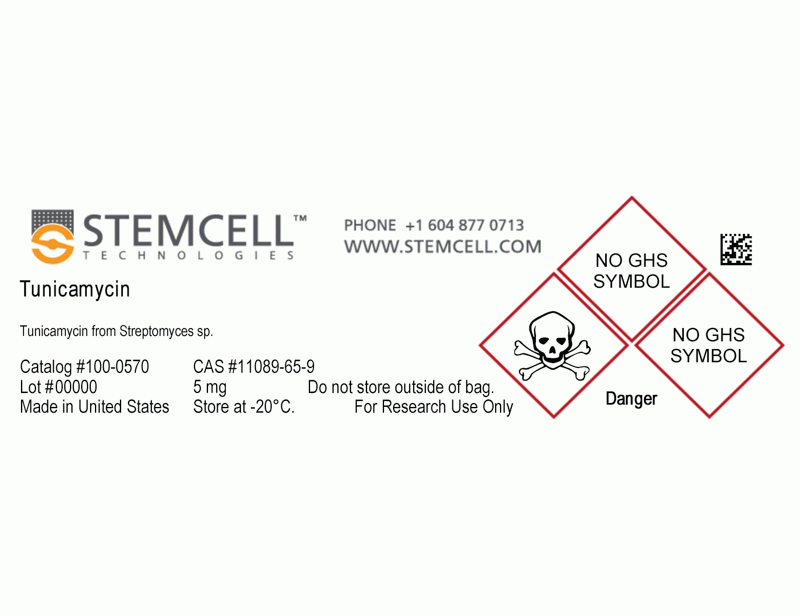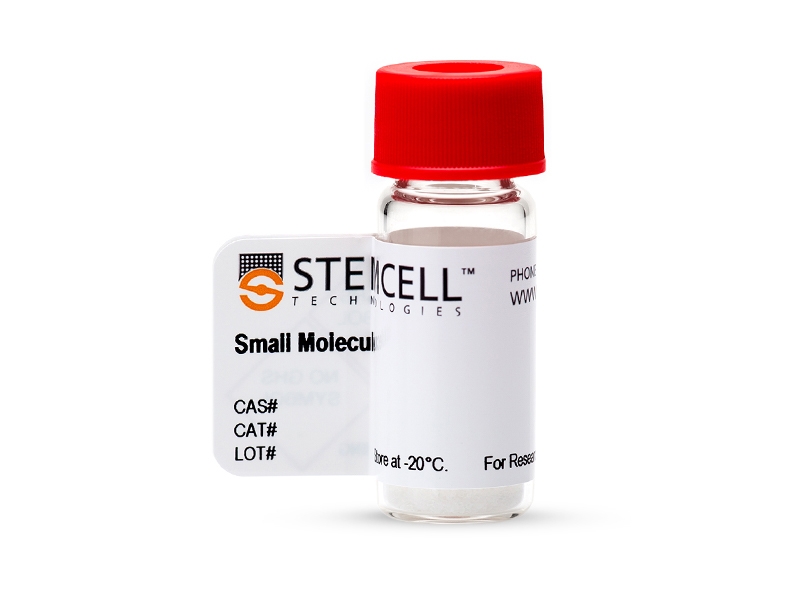Tunicamycin
Nucleoside antibiotic; Inhibits N-acetylglucosamine phosphotransferase
概要
Tunicamycin is a nucleoside antibiotic and an N-acetylglucosamine phosphotransferase inhibitor (Contessa et al.). It also inhibits protein palmitoylation (Patterson & Skene.). Tunicamycin can be used to induce the unfolded protein response and investigate the mechanism of autophagy (Ding et al.).
CANCER RESEARCH
· Radiosensitizes human pancreatic cancer cells to chemotherapy (Contessa et al.).
· Induces endoplasmic reticulum stress and autophagy in cancer cells (Ding et al.).
CANCER RESEARCH
· Radiosensitizes human pancreatic cancer cells to chemotherapy (Contessa et al.).
· Induces endoplasmic reticulum stress and autophagy in cancer cells (Ding et al.).
Cell Type
Cancer Cells and Cell Lines
Area of Interest
Autophagy, Cancer Research
CAS Number
11089-65-9
Chemical Formula
C39H64N4O16 (Tunicamycin VII)
Molecular Weight
845 g/mol
Purity
≥ 95% (mixture of congeners)
技术资料
| Document Type | 产品名称 | Catalog # | Lot # | 语言 |
|---|---|---|---|---|
| Product Information Sheet | Tunicamycin | 100-0570, 100-0571 | All | English |
| Safety Data Sheet | Tunicamycin | 100-0570, 100-0571 | All | English |
数据及文献
Publications (3)
Cancer research 2008 may
Inhibition of N-linked glycosylation disrupts receptor tyrosine kinase signaling in tumor cells.
Abstract
Abstract
Receptor tyrosine kinases (RTK) are therapeutic targets for the treatment of malignancy. However, tumor cells develop resistance to targeted therapies through the activation of parallel signaling cascades. Recent evidence has shown that redundant or compensatory survival signals responsible for resistance are initiated by nontargeted glycoprotein RTKs coexpressed by the cell. We hypothesized that disrupting specific functions of the posttranslational machinery of the secretory pathway would be an effective strategy to target both primary and redundant RTK signaling. Using the N-linked glycosylation inhibitor, tunicamycin, we show that expression levels of several RTKS (EGFR, ErbB2, ErbB3, and IGF-IR) are exquisitely sensitive to inhibition of N-linked glycosylation. Disrupting this synthetic process reduces both cellular protein levels and receptor activity in tumor cells through retention of the receptors in the endoplasmic reticulum/Golgi compartments. Using U251 glioma and BXPC3 pancreatic adenocarcinoma cell lines, two cell lines resistant to epidermal growth factor receptor-targeted therapies, we show that inhibiting N-linked glycosylation markedly reduces RTK signaling through Akt and radiosensitizes tumor cells. In comparison, experiments in nontransformed cells showed neither a reduction in RTK-dependent signaling nor an enhancement in radiosensitivity, suggesting the potential for a therapeutic ratio between tumors and normal tissues. This study provides evidence that enzymatic steps regulating N-linked glycosylation are novel targets for developing approaches to sensitize tumor cells to cytotoxic therapies.
The Journal of biological chemistry 2007 feb
Differential effects of endoplasmic reticulum stress-induced autophagy on cell survival.
Abstract
Abstract
Autophagy is a cellular response to adverse environment and stress, but its significance in cell survival is not always clear. Here we show that autophagy could be induced in the mammalian cells by chemicals, such as A23187, tunicamycin, thapsigargin, and brefeldin A, that cause endoplasmic reticulum stress. Endoplasmic reticulum stress-induced autophagy is important for clearing polyubiquitinated protein aggregates and for reducing cellular vacuolization in HCT116 colon cancer cells and DU145 prostate cancer cells, thus mitigating endoplasmic reticulum stress and protecting against cell death. In contrast, autophagy induced by the same chemicals does not confer protection in a normal human colon cell line and in the non-transformed murine embryonic fibroblasts but rather contributes to cell death. Thus the impact of autophagy on cell survival during endoplasmic reticulum stress is likely contingent on the status of cells, which could be explored for tumor-specific therapy.
The Journal of cell biology 1994 feb
Novel inhibitory action of tunicamycin homologues suggests a role for dynamic protein fatty acylation in growth cone-mediated neurite extension.
Abstract
Abstract
In neuronal growth cones, the advancing tips of elongating axons and dendrites, specific protein substrates appear to undergo cycles of posttranslational modification by covalent attachment and removal of long-chain fatty acids. We show here that ongoing fatty acylation can be inhibited selectively by long-chain homologues of the antibiotic tunicamycin, a known inhibitor of N-linked glycosylation. Tunicamycin directly inhibits transfer of palmitate to protein in a cell-free system, indicating that tunicamycin inhibition of protein palmitoylation reflects an action of the drug separate from its previously established effects on glycosylation. Tunicamycin treatment of differentiated PC12 cells or dissociated rat sensory neurons, under conditions in which protein palmitoylation is inhibited, produces a prompt cessation of neurite elongation and induces a collapse of neuronal growth cones. These growth cone responses are rapidly reversed by washout of the antibiotic, even in the absence of protein synthesis, or by addition of serum. Two additional lines of evidence suggest that the effects of tunicamycin on growth cones arise from its ability to inhibit protein long-chain acylation, rather than its previously established effects on protein glycosylation and synthesis. (a) The abilities of different tunicamycin homologues to induce growth cone collapse very systematically with the length of the fatty acyl side-chain of tunicamycin, in a manner predicted and observed for the inhibition of protein palmitoylation. Homologues with fatty acyl moieties shorter than palmitic acid (16 hydrocarbons), including potent inhibitors of glycosylation, are poor inhibitors of growth cone function. (b) The tunicamycin-induced impairment of growth cone function can be reversed by the addition of excess exogenous fatty acid, which reverses the inhibition of protein palmitoylation but has no effect on the inhibition of protein glycosylation. These results suggest an important role for dynamic protein acylation in growth cone-mediated extension of neuronal processes.




